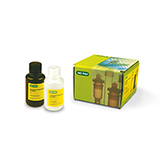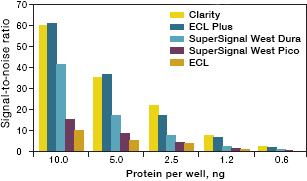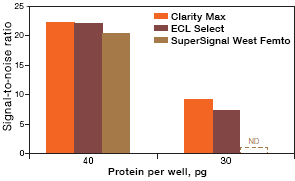
Overview

Find the right products for you using the free Western Blot Selector Tool
Start ToolClarity Family of ECL Western Blotting Substrates
Enhanced chemiluminescence (ECL) is a highly sensitive method for detecting proteins bound to western blotting membranes. Bio-Rad's Clarity family of ECL substrates provides simple, high-performance solutions for all your western blotting needs.
Clarity ECL Substrate is our most versatile chemiluminescence substrate yielding high signal, low background and a long signal duration. Clarity Max ECL Substrate is the substrate of choice for challenging blots that require maximum levels of sensitivity. Both substrates are compatible with any horseradish peroxidase (HRP) conjugate and ideal for all western blots and both digital and film-based imaging. Substrate components are stable at room temperature.
Clarity Western ECL Substrate
Use Clarity Western ECL Substrate with any HRP-conjugated secondary antibody for digital or film-based imaging of western blots.
Features and Benefits
- Mid-femtogram-level sensitivity
- 24-hour signal duration
- 1-year shelf-life at room temperature
- Ideal for digital and film-based imaging
Clarity ECL Substrate exhibits excellent visual limit of detection versus other commonly used ECL substrates on the market.
Clarity Max Western ECL Substrate
Use Clarity Max Western ECL Substrate with any HRP-conjugated secondary antibody for digital or film-based imaging of any western blots.
Features and Benefits
- Low-femtogram-level sensitivity
- Recommended for detection of low target amounts
- Ideal for digital and film-based imaging
Clarity Max ECL Substrate exhibits superior visual limit of detection versus other commonly used high-performance ECL substrates on the market.
Packaging Options
Ordering
items
Use the filters below to refine results!

Pkg of 1, contains 10 ml Clarity Western Peroxide Reagent and 10 ml Clarity Western Luminol/Enhancer Reagent

Pkg of 1, contains 100 ml Clarity Western Peroxide Reagent and 100 ml Clarity Western Luminol/Enhancer Reagent


Pkg of 1, contains 10 ml Clarity Max Western Peroxide Reagent and 10 ml Clarity Max Western Luminol/Enhancer Reagent

Pkg of 1, contains 50 ml Clarity Max Western Peroxide Reagent and 50 ml Clarity Max Western Luminol/Enhancer Reagent





